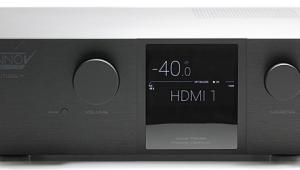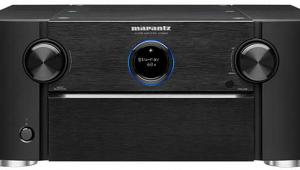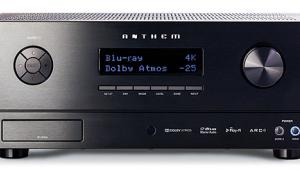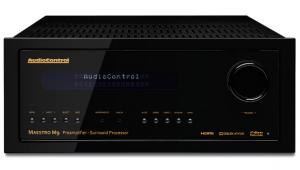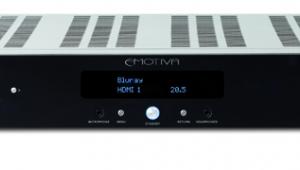I got an XMC-1 and I do agree with the sound quality being "Decision 1". I love the sound of the unit; best of all, it has reference quality analog audio (balanced XLR/RCA) path for reference audiophile two channels listening. I hope Emotiva keeps its promise on making the XMC-1 "completely modular and up-gradable to meet future standards."
Emotiva XMC-1 Surround Processor Review

AT A GLANCE
Plus
Dirac Live speaker/room EQ
Highly flexible setup and automation options
Division I sound quality
Async-USB DAC input for streaming playback
Minus
Only one Dirac curve-set at a time can be loaded
Requires personal computer for setup; no onboard auto calibration
THE VERDICT
A noteworthy addition to the high-end preamp/processor ranks, with Dirac Live a fascinating, must-hear plus.
Talar du svenska? Emotiva does. Enough Swedish, at any rate, for the Tennessee tenderer of direct-to-consumer A/V gear to bake Swedish firm Dirac’s speaker/room-correction DSP into its new preamp/processor, the long-awaited XMC-1.
If you’ll forgive a Miller analogy, Dirac is to Uppsala University as Audyssey is to USC: Dirac, too, evolved out of original academic electroacoustics research—although USC’s weather is better, and I’m pretty sure the Trojans could take the Swedes on the gridiron.
Of Dirac’s several scalable DSP technologies for mobile, personal, and in-room audio playback, Dirac Live is the one inhabiting the XMC-1. Its conceptual architecture is quite similar to that of Audyssey’s MultEQ XT, with a couple of important distinctions. First, Dirac Live runs on an external computer to perform the initial number-crunching, ultimately downloading the resultant filter coefficients to the preamp’s onboard, dual-32-bit Texas Instruments DSP engine. (Emotiva thoughtfully provided me with a Lenovo laptop preloaded with the Windows software, which otherwise must be downloaded; a Mac OSX version is also downloadable.)
Second, and significantly, according to the Swedish tech team, Dirac Live employs “mixed-phase” digital filters, claimed to implement effective impulse (time-domain) corrections as well as frequency-response (amplitude-domain) ones. The mathematics of this are a bit above my pay grade—OK, they’re way, way above my pay grade—but the result is said to be improved resolution, imaging, and spatial presentation, along with the expected real-world, in-room frequency-response corrections. (You can experiment with Dirac Live on your Mac or PC in a free trial, available at dirac.com.)
Emotiva equips the XMC-1 with eight HDMI inputs, trios of coax and optical digital ports (plus a single AES/EBU input), and handfuls of analog paths, including a 7.1-channel analog-direct grouping, but there are no analog video facilities whatsoever—neither component nor composite nor S-video. And there’s no onboard video processing: The Emotiva is strictly a 3D/4K-ready HDMI switcher (HDMI v1.4b), a design approach I find perfectly sensible for the ’phile buyer today. In this market, either source or display (or both) is likely to incorporate adequate processing, should any be desired.
While we’re on the topic of HDMI: Emotiva specs the XMC-1’s v1.4b ports as fully capable with 30-frame-per-second 4K video and claims they in fact would handle 60/4K but for the lack of the critical HDCP 2.2 copyright management, for which the implementing chips that Emotiva plans to use are not yet available. The company says that a full HDMI v2.0 (with HDCP 2.2) upgrade will become available, at an unspecified future date (fairly soon, they hope), on a quick-turnaround basis (it’s a simple board swap). The upgrade’s cost is also still unspecified, but the Tennesseans stressed that it would be modest, and effectively “cost-plus”-priced.

Nine analog channel outputs include dual/stereo subwoofer outs, and all nine are present on both unbalanced RCA and balanced XLR jacks. I used the former; my power amp doesn’t supply balanced inputs, and anyway, I don’t feel that balanced connection offers any meaningful benefit to short runs.
Setup
Setting up the XMC-1 was a pleasure, at least after I received a second, properly functioning unit from Emotiva. The first they sent me, apparently invested by the unquiet shade of the late Harry Pearson, who despised all things digital, exhibited electronic behaviors reminiscent of that little girl in The Exorcist. Oddly, whatever inhabited this unit while in my possession left just as mysteriously, as company reps later reported they could find absolutely nothing wrong with it, even after a week of running it steadily.
In any event, the XMC-1’s setup system itself is workmanlike: The large, excellently readable OLED front-panel display is exactly mirrored onscreen, though in a default size small enough to make me crane a bit from my seating location 9 feet away. (You can stretch this, and change colors via the Setup menu, which helps a lot.) Once I got the hang of their grid-concept structure, menus proved perfectly straightforward and mostly self- explanatory. Inputs can be freely associated with connected sources, as well as extensively customized with regard to default stereo and surround listening modes, setup and equalization presets, and more.
The XMC-1 arrives from Emotiva with a license for Dirac Live LE. The full version I tested is a $99 upgrade, which differs from the LE version by one important attribute: The LE offers a valuable user-definable target-curve capability I’ll describe below. It also offers more flexible mic- and channel-gain adjustments, as well as the option to employ a third-party calibrated test mic. Given the XMC-1’s $2,499 price tag, I suspect the $99 Dirac upgrade box is one many buyers will choose to tick.
The XMC-1 has no built-in auto-calibration routine in the usual sense. Each channel’s distance, level, and crossover must be set manually via the menus—though the Dirac Live routine, when you run it, handles the first of these, but only for the Dirac preset (which is one of three). Consequently, I set these parameters the old-fashioned way, via a handheld SPL meter.
Emotiva provides a downmixing second-zone stereo-audio output, along with unusually flexible 12-volt trigger and IR options for system integration. A wired Ethernet connection links the preamp to a home network and thus the Internet—needed for Dirac’s software authentication, and for communication between the pre/pro and the local computer running Dirac Live. The Ethernet connection empowers full IP-based control in a third-party setup, but the XMC-1 itself has no onboard Web server.
The Dirac Live measurement and calibration routine requires that you connect the supplied higher-than-typical-quality measurement mic (USB) to the computer; it also requires that the computer and the XMC-1 cozy up on the same network. My standard home network worked immediately, the pre/pro auto-discovering it via DHCP on its wired connection, the laptop doing likewise via Wi-Fi.
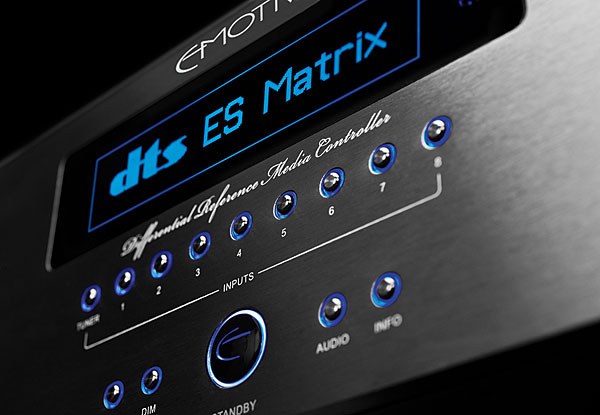
With communications established, I booted up Dirac Live on the laptop, which proved nicely self-prompting and not terribly different interface-wise from Audyssey’s system or several others I’ve tried. One functional distinction is that you must manually adjust the mic input, and individual channel-output gains fairly precisely, before you begin. (But you’ll have to do this only once, if you follow instructions well—don’t ask me how I know.) Dirac Live takes data from nine mic positions, prescribing quite specific locations depending on your seating layout, which it queries. (That said, my reading of Dirac materials online confirmed that it’s mostly the dimensional differences among placements, rather than adherence to specific locations per se, that foment the magic.)
The actual data-collecting routine consists of impulse stimuli, circulating to each channel, for each of the nine positions; once through, the whole routine took me about an hour. With all the data assembled, Dirac Live lets you view plots of the as-found response of each mic position (or averages) for each channel, with the corrected-response overlays, in either amplitude or impulse mode. It’s endlessly fascinating if you’re geeky enough to crave such info, and I am. Dirac’s is the best and most informative such display I’ve encountered among the half-dozen or so systems I’ve experienced, and the software is quick and responsive.
As with all speaker/room- correction systems I know of, Dirac Live’s filters strive to deliver real-world response fitted to an idealized “Target Curve.” Unlike many other systems, Dirac displays this onscreen, and lets you modify it at will. The XMC-1’s out-of-the-box Target Curve tilts downward about 0.5-decibel-per-octave from 100 hertz on up, which largely mirrors what I consider ideal for my system and indeed for most others. You can recalculate your data to a different target (or individual targets by channel) by manipulating curves onscreen, pulling down or up on curve “handles” you click into place, and you can store as many Dirac curve-sets (“Projects”) as you like on the computer. However, only one curve-set at a time can be loaded into the XMC-1, which makes comparisons between curves a 5-minute-per-switch affair at the least.
Overall, I found the Dirac Live app pleasantly straightforward and easy to use—once I noticed the tiny “Help” tab waaay over to the right, which revealed all when clicked. (Is the screen-edge, Where’s Waldo help tab a Windows 8 thing?)
Listening and Use
With its big blue display and intensely blue-backlit controls, the XMC-1 lights up like a Christmas tree when you turn it on. Fortunately,
all this is dimmable, right down to “off,” in the setup options. Since the Emotiva is really a Linux computer in A/V-preamp guise, the unit takes a full 40 seconds to come to life and pass audio and video from a cold start. (There’s an optional Video On Standby mode, which passes video and audio to the TV when the preamp is off and thus keeps the OS loaded, making full startup far quicker.)
Once on, the XMC-1 delivers the goods. I’m going to dispense with my non-Dirac listening fairly quickly here to conserve space: In stereo or unprocessed multichannel playback, the Emotiva sounded indistinguishable from my everyday pre/pro. Which is to say, essentially trans- parent, delivering programming as intended, whether in stereo or in surround. The XMC-1 includes both Reference Direct and “plain” Direct modes, which eliminate or limit processing (including Dirac), as well as Stereo and All Stereo (“party”) modes, which do not. Beyond these, what comes in is what comes out. The XMC-1 offers Dolby TrueHD and DTS-HD Master Audio, and it can employ PLIIx or Neo:6 post-processing to fill in channels missing in the original recording (and also, obviously, to perform matrix-decoding/synthesizing for surround from two-channel programs). Dolby Atmos and DTS:X object-based processing, the latest surround flavors of the month, are absent, perfectly understandable in what is, after-all, only a seven-channel pre/pro. Emotiva says it’s reserving Atmos and DTS:X for an upcoming more-channels model under development.
But as far as the listening goes, the real story here is the Dirac Live processing. As a rule, I report on familiar EQ systems like Audyssey’s only in brief, but Dirac’s, being a debut in these pages, presents a different case.
I spent considerable time comparing the XMC-1’s Dirac preset with its direct, non-Dirac Preset 1, which I carefully set with correct levels and distances. And I quickly heard a perfectly distinct difference.
- Log in or register to post comments


I'm an Emotiva fan and have lots of their stuff. However, my UMC-200 (now discontinued) doesn't have auto lip sync and to my knowledge this $2000 unit doesn't either. Yes, you can manually adjust it, but how old do you think that gets? The best audio quality in the world isn't worth a dime if it's out of sync.
Note to Emotiva - auto lip sync is a requirement.

I have the XMC-1. I don't have limpsync problems. I am not sure about the UMC-200. You could check their forums emotivalounge.proboards.com --or call Emotiva support for a solution. The timing is taking off the video via HDMI protocol. Maybe your TV/projector is doing heavy processing causing a delay hance sync problems.

type-o it's "Lip-sync"

I left my Lip sync at "Auto" and don't have a problem. Do you have any post processing video devices? No? Try defeating all video processing on your display. The HDMI works on video timing hence the sync in audio with video.

How would you compare these room correction systems??
What frequency does Dirac do its corrections at?? Audyssey does it at 48khz, ARC at 96khz.
It was a little unclear to me if you can do two separate corrections. In ARC you can do a separate 'movie' and 'music' configurations, which is great if you use different speaker configurations-- 7.1 and stereo 2.1 for instance.
I got the impression that you need to set each speaker level to 75db and enter each speaker distance before running Dirac. Is that correct??
If so how precise are the measurements?? To the foot? 1/2 ft.?, inch?
Am I correct in understanding that it does not balance dual subs prior to doing its room correction like Audyssey XT32 does, but the subs need to be balanced either with an outboard system like DSPeaker antimode 2.0 or similar component.
What is your reference pre/pro? it will say a lot about the XMC-1's audio. Are you comparing to an Integra 80.3 or an Anthem D2v?
Lots of questions, but I'm interested to find out more about the XMC-1 and Dirac.

Actually Audyssey is completely dependent on the hardware of the component. It can do processing up to 96kHz if the necessary DSPs are present, but in every implementation I've used it only goes up to 24kHz because of the lack of DSP processing power for it. Also Audyssey XT32 only does dual subs if it also includes SubEQ HT. Most XT32 components have it, but it's not a requirement for XT32.

Dirac is also taxing on the DSPs. I am not sure if it decimates PCM down to 48Khz like the usual Audyssey implemented, but 48Khz sampling rate is still above full-range. What system you had that goes up to 24Khz?
https://en.wikipedia.org/wiki/Sampling_(signal_processing)

I meant it has a sample rate of 48kHz so it only works out to 24kHz. Dirac on the Emotiva works the exact same way.

I recently learned that Audyssey only decoded up to 48khz/16 but. Is that true? Because that would seem to render any hi rez content completely moot.
Also, how can it do processing up to 96kHz with the "necessary DSP"? Could you expand on that if you don't mind?

Audyssey typical implementation usually down-samples to 48Khz/24Bit if native file is 24bit. I am not sure about 16bit, but it's up to the AVR manufacturers DSPs implementations.

According to Audyssey, there is nothing about Audyssey that causes it to be limited to a 48kHz sample rate. Sample rates up to 192kHz or even beyond would be supported. Since correction to 96kHz or 192kHz takes at least 2x or 4x as much processing power as to 48kHz, manufacturers would need to install 1-2 more DSP units to be able to do this. Since most people don't care, and if you can hear that difference is up for debate, it isn't worth it to the companies to support this. So someone could do this, but their unit would cost more than other models with similar features, and it's a feature more people wouldn't understand when they're trying to sell it.

That certainly makes any disc that is 96/24 multi channel essentially worthless. What a total downer if you're looking to listen to hi rez content.... Does anyone know if it decodes full resolution (196/24) in 2 channel??

The implementation of Audyssey on most audio equipment only allows 48khz sampling rate @ 24bit. The reason is because 48khz sampling rate it could reconstruct frequencies up to 22 kHz. Typical human ears could only hear up to 20Khz; hence, giving an AVR extra DSP power at greatest cost for something that most people in the planet wouldn't notice is efficient.
The issue would be how it Audyssey decimates higher PCM sampling rate files of 88, 96 or 192khz down to 48Khz. This computer code could negatively affect sound quality; since now, the native "sound" or bits of the PCM file is being re-sample on the fly to 48Khz. This is one of many reasons most audiophiles don't use EQ and only listen to stereo --but this is all preference.

I have had two of their preamp processors and they are just not reliable over more than a year. My second would not output to the subwoofer...sent it back..yet they were unable to fix it and finally got my full money back...

Emotiva has a five years warranty on most of their equipment. This show how confident they are about their build quality --but I am glad you got your money back.

For highend processors I wish the reviewers would compare the DAC preformace against a known high performer like the OPPO 105. I need to get a new processor but also need to upgrade my Blu-ray. Which would sound better for audio performance... analog input from a 105 or digital input from the OPPO 103?

John, it would be hard to tell the deference between top-of-the-line DACs. The Oppo 105 is an excellent player, but you're looking to update, right? Well, UHD BluRays should be out by the end of the year. If I were you, I would wait. Get something with the latest technology; so you don't need to upgrade again.
The XMC-1 has Dirac which helps with movies, games, music room EQ. It would get HDMI 2.0a, once the standard is set in stone. This mean your new UHD BluRay player would be support once is out. The XMC-1 as analog in. You could use the DAC in a BluRay player like the Oppo. You're ears will tell you which is "best".
In addition, Emotiva said they will keep updating the XMC-1 unit to keep up with the times. I am not sure what this means, but time will tell.

This is John again. My real qustion was intended to elicit a comparison of the XMC-1 Dac versus a well known DAC as is in the OPPO 105. If the XMC is superior then I would not waste the extra money on a more expensive Blu-Ray (UHD or not). I wish reviewers compared the analog input versus digital/HDMI inputs on high end procesors. That simple comparison could save guys like me hundreds of dollars (much more including RCA cables) if the processor digital input and DAC coversion is as good as the analog outputs of high end players like the OPPO 105. Thanks!

In theory, the DAC in the Oppo 105 is better; however, it all depends on the execution on how Oppo implemented the SABRE DAC in their BRP. My understating, it’s the best Blu-Ray player in the world, with the best DAC in the world, on paper. Since, they’re zero comparison between XMC-1 and Oppo 105 sound quality; weight your decision on the feature it brings.
XMC-1 is a processor, so it will give your room EQ, like Dirac, REW support, many HDMI connections, etc. You could use the Oppo 105 as a ‘baby’ processor, but it would scarce the extra HDMI for your other components, room EQ, etc.
If I were you, I would get a processor; and latter get the following Oppo model to the 105, with native 4K, once money allows. The 105 soon will be replaced with a native 4K model. The XMC-1 will be there for some time to come.
“I wish reviewers compared the analog input versus digital/HDMI inputs on high end procesors.”
The analog input in the XMC would bypass the DAC in the XMC-1 and it would use your source’s DAC (Oppo). This is helpful; because it “future proof” the unit by allowing you to use newer/better DACs. Using the HDMI in the XMC-1, would use the DAC in the XMC-1. As far as cables, just get nice build quality cables, and don’t fall for the snake-oil marketing of cable makers. Talk to any electrical engineer or recording studio processional. They don’t use fancy brands cables with exotics “features”: why is that? lol
Anyway, what will you pair the oppo/processor with?

If the XMC-1 did NOT offer a step-up in SQ over the Oppo 105 then I think there would be something wrong with Emotiva's value proposition. After all, it is a dedicated pre/pro (plus tuner) costing significantly more than the Oppo, which is a multi-function device.
By the by, as an Oppo 105 owner I don't think its DAC implementation is anything special, however it may look on paper. Connecting its stereo co-ax output to an external DAC (in my case Metrum Octave Mk I) produces a marked improvement in energy and overall SQ compared to the Oppo's rather lazy delivery.
As a pre/pro the Oppo is also quite basic, with limited functionality that omits any equalisation, dialogue lift, etc, or varying crossover points for each speaker.
For all that, it would be interesting to know how the XMC-1 and 105 compare on SQ, back to back (when the Oppo is used as a source)....


